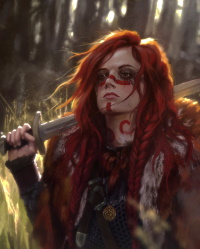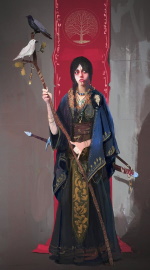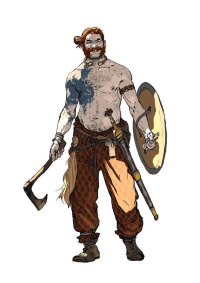The Firdach
The Firdach is a combination of two regions; swampy lowlands and craggy highlands. Ostensibly, it is the most undesirable part of the continent, with little fertile land and few resources to exploit. Its population is fiercely devoted to their land, however, and take immense pride in what they have managed to create within it. The land is divided into tribal groups, though a more centralized nobility is forming in the lowland regions as urban centres develop. Religion in the region is superstitious in nature, with Wit, Asni and the Morrigan the most common deities. Other Routot cults have become more common as of late, as the region becomes less of a backwater and has more positive interactions with their neighbours.
Contents
History
The Firdach has long been overlooked, ignored by most other human groups for its inhospitable and unappealing landscape. The people who did make their homes here clustered together in groups that would eventually become tight-knit clans. These clans fought and warred with each other for most of their history, fractured and isolated against one another. They would periodically raid the Routot to the west, and this animosity would colour their interactions for centuries. More recently, the lowland clans have begun to emulate their more prosperous neighbours, influenced over time by traders and other diplomats who seek to combat the raiders. Some clans have banded together, creating urban centres between their populations to share and help grow their own limited resources.
Society
Nobility
The major tenet of societal life in the Firdach is the existence of family clans. A single elite family sits at their head, landowners who control all the region that the clan lays claim to. Those who fall under their rule are bound to them by tenuous blood connections or oaths of fealty, and provide them with vassalage and support in exchange for protection. Immense pride is placed in the honour of their clan, with loyalty the most valued trait. Upon the death of a clan leader, all clan members vote to select the next clan head from among the ruler’s immediate family. Eligible heirs are typically sons or brothers, though some clans prefer female heirs instead. This process can sometimes fracture clans, breaking them along rival lines. It is a mostly obvious pick, however, and these sorts of clan civil wars are uncommon.
Conflicts
Clan Conflicts
Perhaps the most notable and enduring conflict within the Firdach is among the clans themselves. Throughout their history, clans have warred with one another. They fought for food, land or honour; scrabbling and tearing at what little scraps they shared with the land. Many of these clan wars created enduring rivalries or alliances, passing their legacy and heritage forward to future generations. In this way, even simple slights can lead to outright conflict between two groups, igniting lingering embers of the past into a modern inferno. These old hatreds are strongest today among the highland clans, still clinging to honour above all other currencies. The lowland clans have, of late, placed less emphasis on their dedication to the old ways. Instead, they have managed to put aside these old divisions in place of a more unified and stable society. This difference has fuelled the lowland prosperity, and furthered the isolation of the highland clans.
To add to this division, the lowland and highland clans are linked only through their position at the fringes of the other human realms. A shared culture has done little to actually bring them together, instead they cling to their unique regional identities rather than traditions and customs they practice. While the lowland clans have united to bring their region together, they have largely excluded the highland clans from the same fate. This enmity is prejudiced in nature, believing that the highland clans have always been a more barbarous and backwards people compared to themselves. For their part, the highlanders share this enmity towards the lowlanders, and have little desire to share in their prosperity. This stubborn refusal is borne mostly out of pride, but also links back to their dedication to honour and clan histories. The highlanders feel that they are being left behind, and that the lowlanders are excelling at their expense. All told, this conflict has been simmering for several generations and, as the lowland clans continue to march towards a more prosperous future, seems ready to create the largest clan conflict yet.
Raiding
The clans of the Firdach have long been a raiding culture, venturing into neighbouring lands to pillage and steal. While other clans were the most common targets of these attacks, the Routot to the west have also been heavily assaulted. Animosity has been grown for centuries between these two sides, and the Routot here have focused extensively on limiting the damage the raiders can inflict. Tower homes and fortified settlements are common, forcing the clans to range further and fight harder for their spoils. Some Routot nobles in the area have ventured into the Firdach to try and stop these raids at the source, but these excursions are rarely of any lasting use. Instead, the clans tend to flee from any sort of pitched battle, preferring to use the terrain and pick away at the larger armies arrayed against them. As the lowland clans gather and grow, however, this has begun to change. They have abandoned raids, and have begun to look towards a trading relationship with their former foes. While shaky, this relationship has been relatively successful thus far, and seems to be moving towards a peaceful future. Some of the Routot nobles do not share as bright a view of their neighbours, instead seeing them as much a threat as ever. With the clans united, they will eventually want to push their dominion further, and the eastern marches of the Routot will be prime targets for such a conquest.
Daily Life
The culture of the Firdacians is ancient and archaic, with traditions and customs dating back to time immemorial. Their way of life has remained unchanged for most of their history, and is only now facing pressure to shift and grow. For the lowland clans, this has meant becoming more like the Routot to the southwest. Certain efforts to drain swampland has opened up more room for agriculture, allowing their settlements to grow and prosper beyond what they once were capable of. This has also marked a shift in their own culture, as they begin to graft elements of Routot customs into their own. The most notable among these is religion, where Routot gods have begun to gain a foothold and following in the region. This, combined with newfound trade with the Routot states has made for an influx of new ideas and people into the once isolated lowlands.
For the highland clans, their way of life is much more preserved. They resist any changes to their ancestral traditions, and have begun to view the lowlanders as traitors to the old gods. Here, pride and honour are the most valuable resources for a clan, and they are guarded jealously. Petty warfare here is common, and outside or foreign ideas are barely tolerated. The clans here have little to offer in the way of trade, and scratch a hard living from the rocks and crags.
Notable Factions
Notable Places
Lichoan
The largest settlement among the lowland clans, it was once the capital of the Achiuir clan. It sits at the mouth of the river Cait, and has grown from once humble origins as a fishing village. Docks have been constructed out into the bay, allowing limited trade with some Elvish ships from the south and others further abroad. For the most part, however, Lichoan is still a small trading town. Most of the goods come from overland, its port not yet developed enough to tempt many into making the journey. Food and livestock are brought from the Routot, while other goods are ferried from even further abroad. The town is dominated by a stone tower house, overlooking all on a hill nearby the town itself. The markets are the most notable aspect of the town, surrounded by several boarding houses and other attractions for the merchants who stay in the city. The rest of the settlement is a patchwork of wattle and daub huts and more permanent structures, showcasing the transition its people are undertaking.
Stoaig
While not the largest settlement in the highlands, it is one of the most important. It houses a large complex dedicated to Wit and Asni, the nature gods worshipped in the Firdach. Here, their followers gather for festivals and rituals, celebrating on sacred ground to the old gods. The area is not owned by any particular clan, and is instead seen as a neutral site for negotiations between all clans. Druids gather here to plot the business of their order and administer to their followers. Its location deep within the highlands provides it with the isolation necessary to protect it from outsiders, and make it even more mysterious to those who seek it out.
Notable Personalities
Taran Achiuir, King of Lichoan
The leader of the newly united lowland clans, Taran is an extraordinarily ambitious man. He has managed to bind formerly warring clans together, and amassed quite the fortune in the process. He cares little for the traditional ways of his people, using them only as trappings to acquire their loyalty and drive his own goals forward. His reign has been peaceful, in large part due to his intolerance of any sort of unrest within his realm. While the other clan leaders are nominally his equal in the unification, he is undoubtedly the head of the faction. He is an older man, with black hair and a thick black beard. His eyes are sunken, with a strong brow and a sharp aquiline nose adorning his face. His mouth is kept into a tight, emotionless frown at most times. He is largely humourless, and presents an intimidating presence and aura.

Anca Tarla, Clan Leader
A fierce clan leader, Anca is the leader of the Tarla clan. The Tarla are a highland clan bordering the Routot, who have made themselves wealthy and prosperous off the backs of their neighbour’s fortune. Raids from their warriors are feared, and rightly so, for the Tarla are some of the fiercest warriors in the Firdach. Anca is no different from her followers, a strong and violent woman who clings rigidly to the ways of the past. She usurped the title of clan leader from her brother in a bloody familial dispute, and since then has been on a tear throughout the highlands. Several other clans have bowed to her authority, and she seems to be amassing a bloc large enough to rival the lowland clans for dominance of the region. She is short, but makes up for her size with sheer enthusiasm and passion. She has long red hair that she keeps braided with decorative gold bands. Bright eyes are underlined with a smattering of freckles across her face. She is often smiling, her laugh filled with mirth and unhinged emotion.

Bracana Thinmoch, The Bog Queen
A powerful witch and sorceress, Bracana is an enigmatic figure. Legends tells that she was once a princess of a lowland clan centuries ago, who was left as an offering to the Morrigan when she was still a girl. Rather than sacrifice her, the witches took in their new charge and taught her their ways. Bracana excelled in her studies with a natural affinity for magic and ritual, and eventually grew to lead her own coven of witches. There she still resides, having ascended to become one of the most powerful witches in the region. From her home deep within the swamps she watches all within her domain, having some hand or influence in most that occurs. Other witches seek out her counsel and blessing in their own affairs, her power and wisdom legendary among the swamp. Sacrifices are made to her as often as the Morrigan, Bracana seen as their most devoted servant in the world. She is secretive to most outsiders, though when seen she is usually a very beautiful young woman. Long black hair falls freely down her back, contrasting sharply with unblemished pale skin. Skirts drape around her legs, while shawls are layed over her shoulders. Her eyes are dark, and her teeth flash bright white in a mischievous smile. A sharp nose and chin make her pretty, yet somewhat intimidating.

Talorc, High Druid of Wit
Talorc is an energetic and proud druid, the leader of the conclave at the Stoaig. He is the representative of Wit in the world, and exemplifies the father of the wilds perfectly. Fiercely dedicated to his gods, he gave up any trappings of his former clan long ago, content now to live alongside his brothers and sisters in faith. Despite this, he is no less devoted to them than he once was his clan, offering them protection from any who would despoil their sacred ground. Talorc is wild and passionate, owing to great bouts of temper and violence in the worse times. He is kept in check by his partner Letha, who can calm him of these moods. Talorc leads the warriors of Stoaig in defence of their temple, or to interdict wherever the order decides they should. While not old, he is certainly not a young man either. A big man, he is as broad as he is tall. Tattoos cover his left chest and arm, while scars adorn the rest of his body. A small tuft of red hair perches atop his skull, matching the bushy beard that erupts from his chin. His expression is either a wide grin or a deep frown, both of which are equally intimidating. His energy and charisma dominate all in his presence, and few can ignore the great druid when he is nearby.
Letha, High Druid of Asni
The embodiment of Asni in the world, Letha is the partner to Talorc and a ruler of the temple at Stoaig. She is the representative of Asni’s ideals in the world, dedicated to the care and growth of her followers and people. She brings balance to the leadership of the druidic conclave, calming and soothing her more fiery counterpart in Talorc. Letha grew up at the temple of Stoaig, and has known little else other than the warm embrace of the cult throughout her life. Caring and tender, she is renowned for her kindness and wisdom, often called upon to settle disputes between clans and other disagreements. She is older than Talorc, coming near to the end of her time on earth. Despite this, she is filled with energy, and has yet to show signs of age slowing her down. Her hair is grey, and falls delicately down her back. Her features are soft and round, with a gentle mouth simply smiling at her surroundings. Her kind green eyes are remarkable; as green as the richest hill grasses, seeming to carry an endless forest within them.